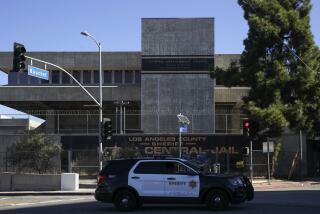Board to Tackle Issue of Flimsy Jail : Escapes: The supervisors are expected to approve spending at least $210,400 for first steps in tightening up the El Cajon lockup to stem tide of breakouts.
- Share via
The county Board of Supervisors is expected today to approve spending as much as $794,000 to make security improvements, some immediately, on the feebly constructed El Cajon Jail, from which 10 inmates have escaped since it opened in 1983.
Supervisor George Bailey, whose district includes El Cajon, is calling for the installation of surveillance cameras and other detection equipment in the nine-story building as soon as possible to help curb jailbreaks.
The jail’s vulnerability was made clear again Nov. 5: Seven inmates escaped from cells on the seventh floor by shinnying down a 250-foot rope made of bed sheets. Three of the prisoners remain at large.
“Any security upgrading is a welcome relief,” said Sheriff’s Capt. Ben McLaughlin, in charge of the jail.
Initial improvements under Bailey’s proposal would cost $210,400. He recommends that the balance--$583,600--be used for “long-term improvements,” primarily fortifying walls and ceilings with galvanized sheet metal, only if the county plans to continue using the El Cajon facility as a jail.
Bailey and other critics have pointed out the jail’s many shortcomings--for example, that inmates have been able to kick holes through cell walls. Such deficiencies have prompted the critics to suggest converting the jail into office space or courtrooms. County officials are studying the feasibility of changing the building’s use.
If Bailey’s proposal is approved by the supervisors, they will appropriate $314,000 from the county’s capital improvement budget for the improvements, allowing initial remedies to get under way. Several attempts to reach Bailey on Monday were unsuccessful.
David Janssen, the county’s assistant chief administrative officer, who has briefed the supervisors about the jail, said the proposal should receive their approval.
“This is something that has to be done, and I think all the supervisors know that,” Janssen said.
County officials are seeking the remaining $480,000--for more substantial improvements--from the El Cajon-San Diego Civic Center Authority, a joint powers authority specifically created to raise funds for the jail’s original construction cost. The authority’s five-member board, which includes Bailey, is expected to approve the allocation, officials say.
“I don’t anticipate that the board would object to this,” said David Janssen, the county’s assistant chief administrative officer.
Besides installing 15 surveillance cameras in the inmate visiting area and on the roof, additional lights would be put up during the first phase of improvements. Bailey’s proposal also calls for the installation of moisture detectors to notify jail officials of leaks. In the past, inmates on the top floors of the nine-story building have been able to jam the pipes, causing flooding in the fifth-floor offices occupied by the probation department staff.
Only the top three floors of the jail contain prison cells; the lower floors house administration offices, courtrooms, probation and records departments and a kitchen, said McLaughlin.
The installation of ceiling “motion detectors,” which trigger an alarm when the ceiling is tampered with, and tamper-proof smoke and fire detectors is also among the proposal’s initial improvements.
If county officials decide to continue using the El Cajon Jail, they will reinforce the interior walls of 130 detention cells by lining them with galvanized sheet metal. Ten holding cells are also targeted for sheet metal reinforcement.
According to Bailey, such measures are needed because the county’s fiscal problems at the time the jail was constructed led to cost-saving inferior materials being used for the walls.
Jane Huston, director of the Department of General Services, described the composition of the jail walls as “plastic and wire mesh and a Styrofoam filling with a textured outer cover.”
Although McLaughlin applauds “Phase 1” improvements as a necessity to handle the immediate threat, he says the facility should be abandoned as a jail.
“The sheet metal will contain the inmates, but nothing is going to correct the poor design of the building,” McLaughlin said. “It’s very labor-intensive.”
For example, because of the lack of monitoring systems and a central command room, a sheriff’s deputy must escort an inmate every time a prisoner is required to leave a cell.
“In a modern jail, a single deputy can summon inmates to a specific location from a central command room,” McLaughlin said. “Cameras follow every step the inmate takes until he gets to his destination.
More to Read
Sign up for Essential California
The most important California stories and recommendations in your inbox every morning.
You may occasionally receive promotional content from the Los Angeles Times.













